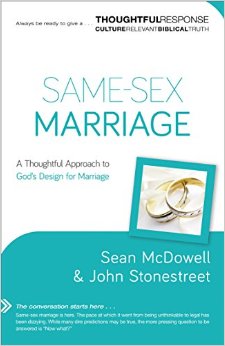 There is an ever-deepening divergence between the church’s understanding of marriage and the culture’s understanding. With the rise of no-fault divorce, common cohabitation, and same-sex marriage, many evangelicals are wondering what we do next.
There is an ever-deepening divergence between the church’s understanding of marriage and the culture’s understanding. With the rise of no-fault divorce, common cohabitation, and same-sex marriage, many evangelicals are wondering what we do next.
Sean McDowell and John Stonestreet have written an immensely beneficial book, Same-Sex Marriage: A Thoughtful Approach to God’s Design for Marriage. The book helps us come to terms with our contemporary setting, how we got here, and how Christians can provide a faithful witness among the ruins of society’s most cherished institution. I asked John and Sean to stop by today to answer a few questions about this book.
Trevin Wax: Your book begins with the assumption that same-sex marriage in all fifty states is likely to soon be legal. Some Christians respond to the shift and think, “That ship is sailed. We can stop talking about this now,” as if the only point of talking about marriage is political! What do you say to those who respond with a shrug to the historical trajectory of embracing gay marriage?
John & Sean: One of the reasons we chose to write on this topic is because of hearing that exact line from a youth pastor of a large church. Even if it’s legal, we thought, how can you say you’re not going to talk about it anymore? For a youth pastor, that would be dereliction of duty. If it is indeed here legally, Christians now have to think through what that means for discipleship, church life, vocational faithfulness, religious freedom, and dozens of other things that are being impacted by the normalization of same-sex marriage.
We wrestle with all of these things in the book, but a fundamental assumption we have is that the legal status of marriage does not alter one bit our Biblical responsibility to it. The last line of the Manhattan Declaration, co-authored by Chuck Colson, Robert George and Timothy George, says it quite well: “We will ungrudgingly render to Caesar what belongs to Caesar, but we can never render to Caesar what belongs to God.”
Trevin Wax: The first part of your book focuses on what you consider to be the central question in this debate: “What is marriage?” Why is it so important to start here?
John & Sean: T.S. Eliot once observed that whenever you come across a new machine, you ask two questions:
- What is it for?
- What can we do with it?
He was writing on education at the time, but his point applies here. Before you decide what to do with something, it is essential to know what that thing is for? Before we decide that marriage should be expanded to include same-sex couples, we must first know what marriage is including the purpose it serves in the larger society.
In the book, we argue this two ways. First, as Christians, we answer the way Jesus answered when he was asked about marriage and divorce. In Matthew 19, he was asked about divorce laws (what to do with marriage), and he took his questioners beyond the law to Genesis (what marriage is for as created by God). This is a strategy we should use. Rather than going to Leviticus or Romans first, we need to understand what God intended for marriage in the Garden!
In Genesis 1-2, the Bible clearly lays out an understanding of marriage as it was intended by God. When folks say, “The Bible never talks about same-sex marriage,” we agree. There are historical reasons for that. But the Scriptures do lay out, from the beginning, a clear understanding of what God intended marriage to be. He started human history with a wedding, in fact.
Second, we also answer the question without referring to Scripture. Our take is that God’s design for marriage is built into the fabric of human existence. So, it’s no coincidence that God’s created intent for marriage has been pretty much universally recognized throughout human history, even by pagan societies, as well.
Even societies that tolerated and promoted homo-erotic activity, did not consider those relationships to be marriage. Why? Not for moral reasons, but for obvious reasons about male-female sexuality and especially children.
Trevin Wax: You lay out two competing definitions of marriage. Can you explain where these definitions come from, and why they matter?
John & Sean: The long-held definition is what Robert George, Ryan Anderson, and Sherif Girgis call the “conjugal” view. This is a bit of a clunky term, but it essentially recognizes that marriage serves a larger purpose than just recognizing sincerely held affections. Primarily its purpose was that of protecting, producing, and preserving future generations. Therefore, marriage is a pre-governmental institution that gives a context for procreation. It’s not created by the state. It’s recognized by the state. This has been the accepted definition for a long-time.
The revisionist view (again to borrow a term from George, Anderson, and Girgis) sees marriage as a human construct. The purpose of marriage in this view is simply to bless strongly held affections. Thus “sincere love” is all it takes to justify marriage, in this view.
These are radically different definitions, and it’s been rightly noted that to transition to the second view will not merely include same-sex couples in this institution. Rather, it fundamentally re-defines marriage for everyone, and will lead to other forms of so-called marriages (and already is).
Trevin Wax: The second half of your book begins with a call to repentance for Christians. What do evangelical Christians need to repent of, and why is it important we begin by looking at our own sins before anyone else’s?
John & Sean: It’s important because it’s what Christ calls us to do. We have to clear up our own houses. In the book, we identify several things that are in need of self-examination by Christians, and therefore repentance.
First, we need to repent for not upholding marriage. Same-sex marriage is only the latest example of how marriage has failed, and it’s not the most important. We have not taught clearly what marriage is. We’ve had seminar after seminar on how to have happy marriages, “godly” marriages, and great sex lives. But because we’ve not taught what marriage is, we’ve essentially decorated a wrong view of marriage with Christian lingo. We’ve also not modeled marriage well. It’s not lost on the larger culture that there were no marches against no-fault divorce or cohabitation, which have been more destructive to marriage than same-sex marriage.
Second, we need to repent anytime we’ve failed to reach out to the LGBT community with the love of Christ. We’ve had a very bad mantra in the church for quite a while, “Love the sinner, hate the sin.” If we did inventory, however, we’ve done much more hating the sin than loving the sinner. Love is not a passive absence of hate. It is active, and we haven’t loved as well as we should have.
Trevin Wax: One of the most hopeful chapters in your book is titled “Giving Marriage Back to the World.” The church has been in similar circumstances before. How have we responded in the past? And how does this prepare us for the future?
John & Sean: Sexually broken cultures are unsustainable, and ours is a sexually broken culture in many, many ways. We’ll continue to see sexual exhaustion set in, both in individuals and in society at large. We think Christians should stop talking about “defending marriage,” and realize that marriage needs to be rebuilt into our society. And the vacuum left in the wake of our sexual exhaustion will provide an incredible opportunity to do what Christians throughout history have done: point to a better way.
We aren’t the first generations of Christians to find ourselves in this kind of a situation. The rumors that Christians always bring in rules to squash the pagan sexual fun are just not true. Some of the first apologists defended Christianity by pointing out that Christians do not share their partners or engage in pederasty. The love their wives, etc. This was an incredible witness, and the more broken the pagan culture became, the more attractive this way of living became.


















